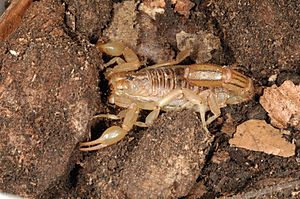Hoffmannius spinigerus facts for kids
Quick facts for kids Paravaejovis spinigerus |
|
|---|---|
 |
|
| Scientific classification | |
| Genus: |
Paravaejovis
|
| Species: |
spinigerus
|
The stripe-tailed scorpion, sometimes called the "devil" scorpion, is a very common type of scorpion. You can find it in Arizona and southwestern New Mexico. It is one of the larger scorpions in its group, called Paravaejovis.
Description
The stripe-tailed scorpion is a medium-sized scorpion. Adult males and females can grow to be about 60–70 mm long. That's about 2.5 to 2.7 inches. They usually weigh around 9.5 g, which is like two nickels.
You can tell this scorpion apart from the Arizona bark scorpion by the brownish-tan stripes on its tail. These stripes run along the ridges of its tail. The stripe-tailed scorpion's tail is usually thicker than its front claws, which are quite thin on bark scorpions. Some of these scorpions might be light yellow or golden brown with darker marks on their tails.
The name spinigerus comes from the small, spine-like bumps found at the ends of the ridges on its tail. Before 2013, this scorpion was known by a different name, Hoffmannius spinigerus.
Habitat
This scorpion lives in the Sonoran Desert. This desert covers parts of Arizona, New Mexico, and California. You can often find it hiding under rocks and other things on the ground, like sleeping bags or shoes. It also likes sandy areas in different places, from flat desert floors to rocky hillsides. It always tries to find the most humid spots it can.
Ecology
Diet
Like most scorpions, the stripe-tailed scorpion mainly eats small invertebrates. This includes other scorpions, crickets, mealworms, and roaches.
Predators
Many animals hunt and eat the stripe-tailed scorpion. These predators include pallid bats, "sand-swimmer" snakes, spiders, centipedes, lizards, birds, and other mammals. Other scorpions might also eat them.
Venom
All scorpions have venom, and the stripe-tailed scorpion is no different. However, its venom is not very strong for humans or other mammals. A sting from this scorpion is not considered dangerous to people.
Reproduction and Life Cycle
Stripe-tailed scorpions use smell and vibrations to find a mate. When a male and female find each other, they might do a special "dance." This dance can last from a few minutes to several hours. After the dance, they usually go their separate ways. If the male keeps dancing longer than the female, she might attack and eat him.
Baby scorpions, called "scorplings," grow inside the female's body. They are born alive. You can often tell a female scorpion is pregnant because her body looks stiff and inflexible. This period, called gestation, usually lasts for 3 to 8 months.
When it's time for birth, the mother lowers her front legs. This allows the scorplings to come out. Some babies emerge one at a time, a few minutes apart. Others might come out all at once in a steady flow. The mother stays stiff until all her babies have left her body. She will carry them on her back and care for them until they go through their first molting period. A female can have anywhere from 1 to 100 scorplings at one time. Sometimes, mothers might eat some of their babies. Scientists are still trying to understand why this happens.
See also
 In Spanish: Alacrán amarillo cola rayada para niños
In Spanish: Alacrán amarillo cola rayada para niños

